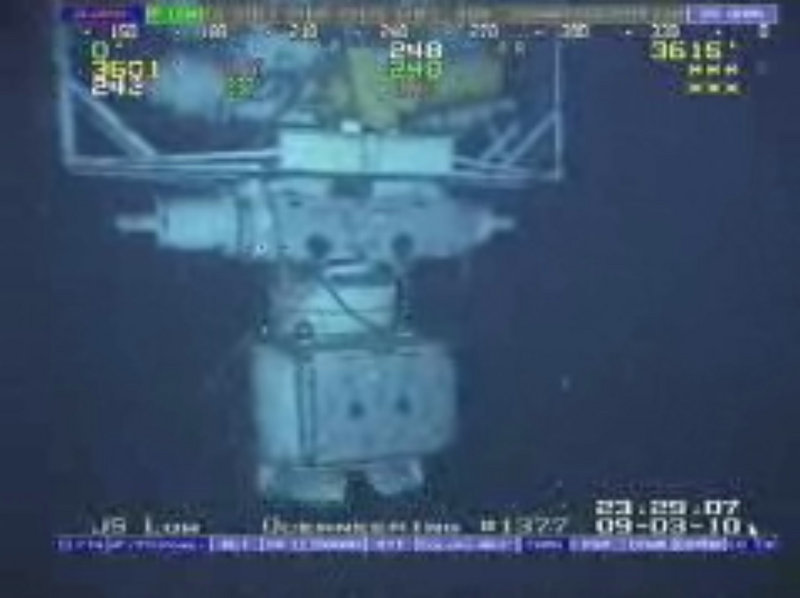ON THE GULF OF MEXICO — A crane hoisted a key piece of oil spill evidence to the surface of the Gulf of Mexico on Saturday, giving investigators their first chance to personally scrutinize the blowout preventer, the massive piece of equipment that failed stop the gusher four months ago.
It took 29 hours to lift the 50-foot, 300-ton blowout preventer from a mile beneath the sea to the surface. The five-story high device breached the surface at 6:54 p.m. CDT, and looked largely intact with black stains on the yellow metal.
FBI agents were among the 137 people aboard the Helix Q4000 vessel, taking photos and video of the device. They’ll escort it back to a NASA facility in Louisiana for analysis.
Crews had been delayed after icelike hydrates formed on the blowout preventer. The device couldn’t be safely hoisted from the water until the hydrates melted because the hydrates are combustible, said Darin Hilton, the captain of the Helix Q4000.
Hydrates form when gases such as methane mix with water under high pressure and cold temperatures. The crystals caused BP PLC problems in May, when hydrates formed on a 100-ton, four-story dome that BP tried to place over the leak to contain it.
The April 20 explosion aboard the Deepwater Horizon killed 11 workers and led to 206 million gallons of oil spewing from BP PLC’s undersea well.
Investigators know the explosion was triggered by a bubble of methane gas that escaped from the well and shot up the drill column, expanding quickly as it burst through several seals and barriers before igniting.
But they don’t know exactly how or why the gas escaped. And they don’t know why the blowout preventer didn’t seal the well pipe at the sea bottom after the eruption, as it was supposed to.
Documents emerged showing that a part of the device had a hydraulic leak, which would have reduced its effectiveness, and that a passive “deadman” trigger had a low, perhaps even dead, battery.
Steve Newman, president of rig owner Transocean, told lawmakers following the disaster that there was no evidence the device itself failed and suggested debris might have been forced into it by the surging gas.
There has also been testimony that the blowout preventer didn’t undergo a recertification process in 2005 as required by regulators.
Recertifying the device requires disassembling it out of the water and can take as long as three months to complete.
Testimony from BP and Transocean officials also showed that repairs weren’t always authorized by the manufacturer, Cameron International, and that confusion about the equipment delayed efforts to close the well in the days after the explosion.
The government said a new blowout preventer was placed on the blown-out well late Friday. Officials wanted to replace the failed blowout preventer first to deal with any pressure that is caused when a relief well that BP has been drilling intersects the blown-out well.
Once that intersection occurs sometime after Labor Day, BP is expected to use mud and cement to plug the blown-out well for good from the bottom.
Send questions/comments to the editors.



Success. Please wait for the page to reload. If the page does not reload within 5 seconds, please refresh the page.
Enter your email and password to access comments.
Hi, to comment on stories you must . This profile is in addition to your subscription and website login.
Already have a commenting profile? .
Invalid username/password.
Please check your email to confirm and complete your registration.
Only subscribers are eligible to post comments. Please subscribe or login first for digital access. Here’s why.
Use the form below to reset your password. When you've submitted your account email, we will send an email with a reset code.